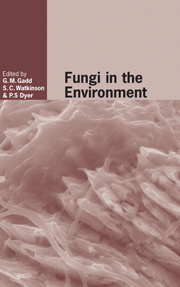Book contents
- Frontmatter
- Contents
- List of contributors
- Preface
- I Imaging and modelling of fungi in the environment
- II Functional ecology of saprotrophic fungi
- III Mutualistic interactions in the environment
- IV Pathogenic interactions in the environment
- 11 Functional genomics of plant infection by the rice blast fungus Magnaporthe grisea
- 12 Exploring the interaction between nematode-trapping fungi and nematodes by using DNA microarrays
- 13 Role of α(1-3)-glucan in Aspergillus fumigatus and other human fungal pathogens
- 14 Plagues upon houses and cars: the unnatural history of Meruliporia incrassata, Serpula lacrymans and Sphaerobolus stellatus
- V Environmental population genetics of fungi
- VI Molecular ecology of fungi in the environment
- Index
- References
14 - Plagues upon houses and cars: the unnatural history of Meruliporia incrassata, Serpula lacrymans and Sphaerobolus stellatus
from IV - Pathogenic interactions in the environment
Published online by Cambridge University Press: 03 November 2009
- Frontmatter
- Contents
- List of contributors
- Preface
- I Imaging and modelling of fungi in the environment
- II Functional ecology of saprotrophic fungi
- III Mutualistic interactions in the environment
- IV Pathogenic interactions in the environment
- 11 Functional genomics of plant infection by the rice blast fungus Magnaporthe grisea
- 12 Exploring the interaction between nematode-trapping fungi and nematodes by using DNA microarrays
- 13 Role of α(1-3)-glucan in Aspergillus fumigatus and other human fungal pathogens
- 14 Plagues upon houses and cars: the unnatural history of Meruliporia incrassata, Serpula lacrymans and Sphaerobolus stellatus
- V Environmental population genetics of fungi
- VI Molecular ecology of fungi in the environment
- Index
- References
Summary
Dry rot in the twenty-first century
Santa Barbara in California is such a stunningly beautiful place that it seems reasonable that this apparent utopia is troubled by one or two things. In the context of fungi in the indoor environment, residents have encountered a pestilence that is transforming homes into rubble and sawdust. Its name is Meruliporia incrassata and it causes dry rot (Figs. 14.1, 14.2). I'll begin with the thoughts of journalist Matt Kettmann, who wrote a story for Santa Barbara's newspaper, The Independent, titled, ‘Invasion of the House-Eating Fungus’ (Kettmann, 2002). Matt interviewed the Kastner family, who had moved into a US $1.2 million ranch-style house. The nastiness began when, ‘a mysterious foam slowly started peeking out of the laundry room walls’. Dry rot was diagnosed and treated by an extermination company. Feeling confident that the fungus was gone, the family left for a vacation. When they returned, Matt explained, nearly a quarter of the house ‘was eaten in a mere week’. Christina Kastner remarked, ‘It came back with a vengeance – like it got mad.’ The problem was solved once the exterminators found a ‘taproot with the diameter of a grapefruit in the rear of the house’.
- Type
- Chapter
- Information
- Fungi in the Environment , pp. 289 - 310Publisher: Cambridge University PressPrint publication year: 2007
References
- 1
- Cited by



